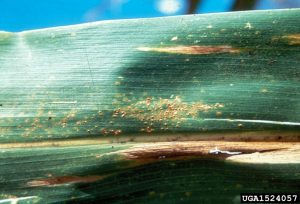Corn Rusts in Wisconsin
Damon L. Smith, Extension Field Crops Pathologist, University of Wisconsin-Madison
I have been receiving lots of questions over the last couple of weeks about rusts in corn. Folks are identifying pustules of common rust on field and silage corn in Wisconsin. Common rust is caused by the fungus Puccinia sorghi. Symptoms can include chlorotic flecks that eventually rise and break through the epidermis to produce pustules of brick-red spores (Fig. 1). Typically these pustules are sparsely clustered on the leaf. They can also appear on other parts of the plant including the husks and stalks. Conditions that favor the development of common rust are periods of high humidity and nighttime temperatures that remain around 70F with moderate daytime temperatures. This fungus needs very little free moisture for infection to occur. Thus, the weather conditions in Wisconsin over the last month have been somewhat conducive for this disease. However, very hot and dry weather can slow or stop disease development.
Management of Common Rust
Management for common rust primarily focuses on resistant hybrids. Most modern commercial hybrids have excellent resistance to common rust. Remember resistance is not immunity, so some pustule development can be observed even on the most resistant hybrids. Some inbred corn lines and specialty corn can be highly susceptible to common rust. Under these circumstances a fungicide may be necessary to control common rust. Fungicides with efficacy toward common rust can be found on the Corn Fungicide Efficacy Table. Most of the hybrids I have scouted this season have some pustules, however incidence and severity is relatively low. Therefore, a fungicide application to control common rust isn’t needed for most of these hybrids in Wisconsin. Residue management or rotation is typically not needed for this disease as inoculum (spores) have to be blown up on weather systems from the southern U.S.

Figure 2. Southern rust pustules on a corn leaf. Photo credit: Department of Plant Pathology., North Carolina State University, Bugwood.org
A related rust that we need to pay close attention to this season is southern rust. Southern rust is caused by the fungus Puccinia polysora. Symptoms of southern rust are different from common rust in that they are typically smaller in size and are often a brighter orange color (Fig. 2). Pustules of southern rust also typically only develop on the upper surface and will be be more densely clustered. Favorable conditions for southern rust development are similar to those for common rust. high humidity and temperatures around 80F encourage disease development. However, very little free moisture is need for infection to occur. Southern rust is typically a rare occurrence in Wisconsin. When it does occur, it is usually in the southern and southern western portions of the state, with epidemics initiating late in the season. Spores of this fungus have to be blown up from tropical regions or from symptomatic fields in the southern U.S. The fungus can not overwinter in Wisconsin. While southern rust epidemics can be rare events in Wisconsin, the disease can be serious when it occurs. Therefore close monitoring of forecasts and scouting are needed to make timely in-seaosn management decision.
Currently the Corn Southern Rust iPIPE map is showing numerous confirmed cases of southern rust in the southern, southeastern U.S. and Kansas and Kentucky. No confirmed cases have been identified in Illinois, Iowa or Wisconsin. However, close attention should be paid to this disease in 2016 as the confirmed cases this year have been earlier than in the past. This could mean that conditions are ripe for movement of southern rust inoculum into Wisconsin.
Management of Southern Rust
Traditionally resistance was used to manage southern rust. However, in 2008 a resistance-breaking race of the southern rust fungus was confirmed in Georgia. Thus most modern hybrids are considered susceptible to southern rust. Rotation and residue management have no effect on the occurrence of southern rust. The southern rust fungus has to have living corn tissue in order to survive and can not overwinter in Wisconsin. Fungicides are typically used to control southern rust in parts of the U.S. where this is a consistent problem. Efficacy ratings are also available for fungicides against southern rust on the Corn Fungicide Efficacy Table. Should southern rust make its way to Wisconsin prior to the “milk” (R3) growth stage in corn, it could cause yield reductions. Growers and consultants should scout carefully through the R3 growth stage and be sure to properly identify the type of rust observed. If you need assistance in identifying rust on corn, leaf samples of corn plants can be sent in a sealed plastic bag with NO added moisture to the University of Wisconsin Plant Disease Diagnostic Clinic (PDDC). Information about the clinic and how to send samples can be found by CLICKING HERE.
Other Useful Resources about Rusts on Corn
Purdue Extension Fact Sheet – Common and Southern Rusts of Corn
2014 Crop Alert – University of Nebraska
Video by Dr. Tamra Jackson-Ziems of the University of Nebraska – Identifying Rust Diseases of Corn




